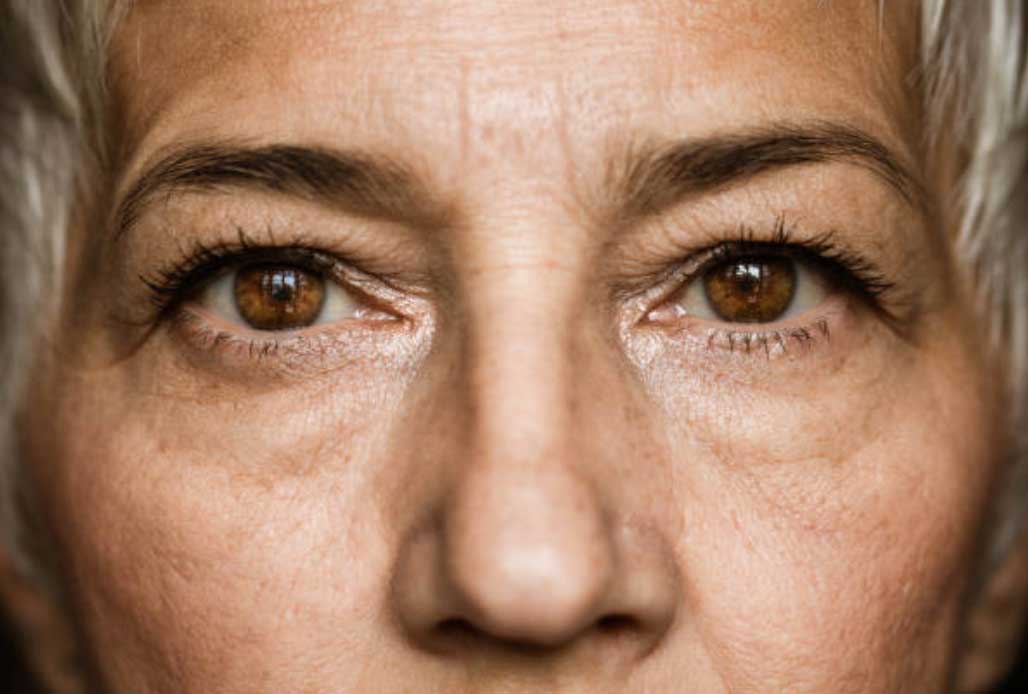Strategies for Treating Crepey Skin Following Eyelid Surgery
Eyelid surgery is a cosmetic procedure performed to improve the appearance of the eyelids. It can be done for a variety of reasons, ranging from improving vision impaired by drooping eyelids to enhancing facial aesthetics. While this surgery has high success rates and can significantly boost the appearance and functionality of the eyelids, it is not without potential side effects. One such side effect is the development of “crepey skin” – a condition where the skin becomes unusually thin, finely wrinkled, and less elastic, often giving a crêpe-like appearance.
Consultant Plastic Surgeon Anthony MacQuillan stands as one of the most experienced plastic surgeons in the UK, specialising in facial surgery. His commitment to achieving optimal outcomes for his patients is evident in his use of advanced surgical techniques and a personalised approach, ensuring each procedure is specifically tailored to meet the distinct requirements of every individual.
Eyelid Surgery – Impact on Skin Texture
Eyelid surgery can be categorised into several types, including Upper Eyelid, Lower Eyelid and Double Eyelid surgery. Each type targets specific concerns. For instance, upper Eyelid surgery is often pursued to remove excess skin that can droop and impair vision, while lower Eyelid surgery primarily addresses bags under the eyes and fine wrinkles. Double Eyelid surgery, popular in many East Asian countries, creates a crease in the eyelid where one does not naturally occur.
Post-surgery, the skin around the eyes can undergo several changes. While incisions are made as discreetly as possible, the healing process can sometimes lead to alterations in skin texture. Factors like age, skin quality, and individual healing processes play a significant role. In some cases, the skin might become thinner and lose some of its natural elasticity, leading to the appearance of crepey skin.
What is Crepey Skin and Why Does It Occur?
This term is colloquially used to describe skin that has become thin, finely wrinkled, and has a slightly loose or saggy appearance. It often resembles crêpe paper, which is where the name derives from. This condition is particularly noticeable in areas where the skin is naturally thinner, such as around the eyes.
Several factors can contribute to the development of crepey skin after Eyelid surgery;
- Age is a significant factor; older patients may have less collagen and elastin in their skin, making it more prone to wrinkling and sagging post-surgery.
- The surgical technique used can also play a role; overly aggressive removal of fat or skin can exacerbate this condition.
- Additionally, individual healing responses, which vary greatly among patients, can influence the skin’s appearance after surgery.
- Environmental factors, like sun exposure, and lifestyle choices, such as smoking or poor nutrition, can also impact the healing process and the eventual appearance of the skin.
What to Expect After Eyelid Surgery
The period following Eyelid surgery is important for recovery and the ultimate appearance of the eyes and surrounding skin.
Immediate Post-Surgery Effects
- Common symptoms immediately after surgery: In the first few hours and days following Eyelid surgery, patients can expect swelling, bruising, and discomfort around the eyes. These symptoms are a normal part of the body’s healing process. The degree of swelling and bruising varies from person to person but peaks within the first week before gradually subsiding.
- Initial care and precautions to take: Immediate post-operative care is essential. Patients are usually advised to keep their head elevated, even while sleeping, to reduce swelling. Applying cold compresses can also help. It’s important to follow Anthony’ instructions regarding eye drops or ointments to prevent infection and aid in the healing process. Avoiding strenuous activities, smoking, and exposure to irritants is also recommended during this period.
Timeline of the Healing Process
- Week-by-week breakdown of the expected healing stages: In the first week, patients generally experience the most discomfort and visible swelling. By the second week, major swelling subsides, and patients often feel comfortable appearing in public, though some residual swelling may persist. Over the next several weeks to months, the skin continues to heal, and the final results of the surgery begin to emerge. Complete healing and the stabilisation of results can take several months.
- Duration until full recovery is typically observed: Full recovery time varies, but most patients can expect to see the final results of their Eyelid surgery within several months. It’s essential to have regular follow-ups with Anthony to monitor the healing process.
Signs of Normal Healing vs. Complications
- What to expect during a normal healing process: Normal healing involves gradual reduction in swelling and bruising, without significant pain. The incision lines should steadily become less noticeable.
- Red flags and signs of potential complications: Any signs of infection (such as increased redness, warmth, or pus discharge), severe or increasing pain, vision changes, or abnormal swelling should be reported to Anthony’s team immediately. These could be signs of complications requiring prompt medical attention.
Treatment Options for Crepey Skin after Eyelid Surgery
Treating crepey skin after Eyelid surgery involves a complex approach, combining medical interventions, natural remedies, and lifestyle modifications. These treatments aim to improve skin texture, promote healing, and restore the skin’s natural elasticity.
Medical Treatments
- Prescribed topical treatments and their roles: Anthony may prescribe topical retinoids or other creams that encourage skin cell turnover and collagen production. These products can help in improving the texture and elasticity of the skin.
- The potential of laser therapy in skin texture improvement: Laser resurfacing treatments can be effective in treating crepey skin by removing the outer layers of skin, stimulating collagen production, and promoting the growth of new, healthier skin. It’s a popular choice for enhancing skin texture post-surgery.
- Role of injectable treatments in enhancing skin quality: In some cases, injectable treatments like fillers or neuromodulator injections may be recommended. Fillers can add volume and reduce the appearance of wrinkles, while neuromodulators can relax the muscles around the eyes, decreasing the formation of new wrinkles.
Natural Remedies
- Herbal supplements known for skin health: Certain supplements, like vitamin C, vitamin E, and omega-3 fatty acids, are known for their skin-rejuvenating properties. They can help in repairing and maintaining healthy skin.
- Effective home remedies for skin texture improvement: Natural remedies like aloe vera, cucumber slices, and green tea bags can be used for their soothing and anti-inflammatory properties. They can help reduce swelling and improve skin texture.
- Importance of hydration and diet in skin recovery: Staying well-hydrated and maintaining a balanced diet rich in antioxidants, vitamins, and minerals is essential for skin health. Foods high in protein, vitamins A and C, and other nutrients support skin repair and collagen production.
Lifestyle Changes
- Importance of adequate sleep and its impact on skin healing: Getting enough rest is crucial for the body’s healing process. During sleep, the body repairs itself, which is essential for skin recovery.
- Exercise and physical activity considerations during recovery: While strenuous activities should be avoided immediately after surgery, gentle exercises like walking can promote blood circulation and aid in the healing process.
- Stress management and its relation to skin health: High-stress levels can negatively impact skin healing. Practices like meditation, yoga, or simply engaging in enjoyable activities can help manage stress.
Incorporating these treatments and lifestyle changes can significantly improve the appearance of crepey skin after Eyelid surgery and promote overall skin health.
Tips for Preventing Crepey Skin Post-Surgery
- Best practices to follow immediately after surgery: To minimise the risk of developing crepey skin, it’s important to follow all post-operative instructions from Anthony. This includes caring for the incision sites, avoiding rubbing or straining the eyes, and protecting the area from excessive sun exposure.
- Skincare products and routines to adopt: Implementing a gentle skincare routine is key. Use mild, hypoallergenic products that are less likely to irritate the delicate skin around the eyes. Products rich in peptides, hyaluronic acid, and ceramides can help in maintaining skin hydration and elasticity.
- The role of sun protection in preventing skin damage: Sun exposure can significantly damage skin, leading to premature aging and worsening the appearance of crepey skin. Using a broad-spectrum sunscreen, wearing sunglasses, and avoiding direct sun exposure, especially in the peak hours, are essential preventive measures.
Long-term Skincare Routines for Maintaining Results
- Daily skincare routines to enhance skin elasticity and texture: A daily skincare routine that includes cleansing, moisturising, and applying sunscreen can help maintain the results of your surgery. Incorporating anti-ageing products can further enhance skin quality.
- The importance of regular check-ups with Anthony: Regular appointments with your plastic surgeon can help in monitoring the health of your skin and the results of your surgery. He can also provide advice on any additional treatments or changes in your skincare routine.
- Adjustments in skincare as you age: As your skin changes with age, so should your skincare routine. Your plastic surgeon can guide you in making these adjustments to ensure that your skin remains healthy and vibrant.
When to Consult a Professional for Further Treatment
- Understanding the signs that warrant professional advice: If you notice persistent problems with your skin texture, increased wrinkling, or other concerns, it’s important to consult with your surgeon.
- The benefits of regular follow-ups post-surgery: Regular follow-ups help in early detection and treatment of any issues, ensuring the best possible outcome from your surgery.
- Options for additional treatments if crepey skin persists: If crepey skin remains a concern, there are additional treatments such as chemical peels, micro needling, or further laser therapy that can be considered.

FAQs about How to Treat Crepey Skin after Eyelid Surgery
What are the most effective home remedies for managing crepey skin after Eyelid surgery?
While home remedies cannot replace professional medical treatment, they can complement the healing process. Here are some effective strategies:
- Hydration: Keeping the body well-hydrated helps maintain skin elasticity. Drinking plenty of water is key.
- Gentle Skincare Products: Using mild, hypoallergenic cleansers and moisturisers can nourish the skin without causing irritation.
- Sun Protection: Wearing sunglasses and applying sunscreen regularly protects the delicate skin from further damage.
- Proper Nutrition: A diet rich in antioxidants, vitamins C and E, and omega-3 fatty acids can support skin health and repair.
- Avoid Smoking and Excessive Alcohol: These can impair skin healing and elasticity.
Are there any specific skincare products recommended for crepey skin post-Eyelid surgery?
Yes, certain skincare products are particularly beneficial for crepey skin after surgery. Look for products that contain:
- Retinol: Helps in skin renewal and collagen production.
- Peptides: Aid in the skin’s natural healing and rejuvenation processes.
- Hyaluronic Acid: Provides hydration and plumps the skin.
- Antioxidants: Such as vitamin C, which can help protect and rejuvenate the skin. Always consult with your plastic surgeon before applying new products to the surgical area.
How long does it usually take for crepey skin to improve after Eyelid surgery?
- The time it takes for crepey skin to improve post-surgery varies depending on individual factors like age, skin type, and overall health. Most patients may start to see improvements within a few weeks to a few months. However, complete skin remodelling and healing can take up to a year. Consistent skin care and following your surgeon’s advice are crucial during this period.
Can professional treatments help with crepey skin after Eyelid surgery, and what are the options?
Professional treatments can be very effective in improving the appearance of crepey skin after Eyelid surgery. Some popular options include:
- Laser Therapy: Helps by stimulating collagen production and improving skin texture.
- Chemical Peels: These can improve surface-level skin texture and tone.
- Microneedling: Encourages natural skin regeneration and collagen production. It’s important to consult with your surgeon to determine the best treatment plan for your specific condition.
When should I consider seeking medical advice for crepey skin after Eyelid surgery?
If you notice the following, it’s advisable to seek medical advice:
- No Improvement: If there’s no improvement in skin texture within a few months post-surgery.
- Worsening Condition: If the crepey skin worsens or other symptoms like excessive dryness, redness, or itching occur.
- Concerns About Healing: Any concerns regarding the healing process or the appearance of your eyelids. A professional can provide tailored treatment options, reassurance, and guidance for optimal recovery.
Further Reading about Face Procedures with Consultant Plastic Surgeon Anthony MacQuillan
- How to Remove Stitches after Blepharoplasty
- How to Reduce Bruising and Swelling after Facelift
- Recovery after Blepharoplasty
- Procedures to Have with a Facelift
- Hooded Eyelids
Medical References about Crepey Skin after Eyelid Surgery
- Important Considerations in Eyelid Rejuvenation – American Society of Plastic Surgeons
- Pinch Blepharoplasty: A Safe Technique with Superior Results – Oxford Academic
- Crepey Skin: Treatment, Causes, And How to Treat It – Medical News Today
- Blepharoplasty (Eyelid Surgery) – WebMD



